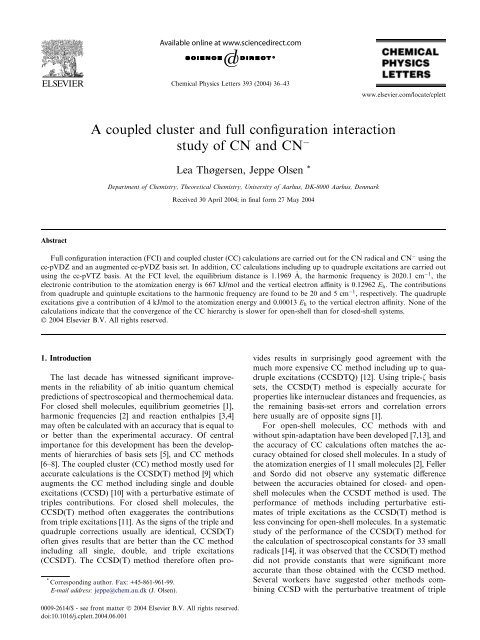Get my PhD Thesis
Get my PhD Thesis
Get my PhD Thesis
You also want an ePaper? Increase the reach of your titles
YUMPU automatically turns print PDFs into web optimized ePapers that Google loves.
Chemical Physics Letters 393 (2004) 36–43<br />
www.elsevier.com/locate/cplett<br />
A coupled cluster and full configuration interaction<br />
study of CN and CN<br />
Lea Thøgersen, Jeppe Olsen *<br />
Department of Chemistry, Theoretical Chemistry, University of Aarhus, DK-8000 Aarhus, Denmark<br />
Received 30 April 2004; in final form 27 May 2004<br />
Abstract<br />
Full configuration interaction (FCI) and coupled cluster (CC) calculations are carried out for the CN radical and CN using the<br />
cc-pVDZ and an augmented cc-pVDZ basis set. In addition, CC calculations including up to quadruple excitations are carried out<br />
using the cc-pVTZ basis. At the FCI level, the equilibrium distance is 1.1969 A, the harmonic frequency is 2020.1 cm 1 , the<br />
electronic contribution to the atomization energy is 667 kJ/mol and the vertical electron affinity is 0.12962 E h . The contributions<br />
from quadruple and quintuple excitations to the harmonic frequency are found to be 20 and 5 cm 1 , respectively. The quadruple<br />
excitations give a contribution of 4 kJ/mol to the atomization energy and 0.00013 E h to the vertical electron affinity. None of the<br />
calculations indicate that the convergence of the CC hierarchy is slower for open-shell than for closed-shell systems.<br />
Ó 2004 Elsevier B.V. All rights reserved.<br />
1. Introduction<br />
* Corresponding author. Fax: +45-861-961-99.<br />
E-mail address: jeppe@chem.au.dk (J. Olsen).<br />
The last decade has witnessed significant improvements<br />
in the reliability of ab initio quantum chemical<br />
predictions of spectroscopical and thermochemical data.<br />
For closed shell molecules, equilibrium geometries [1],<br />
harmonic frequencies [2] and reaction enthalpies [3,4]<br />
may often be calculated with an accuracy that is equal to<br />
or better than the experimental accuracy. Of central<br />
importance for this development has been the developments<br />
of hierarchies of basis sets [5], and CC methods<br />
[6–8]. The coupled cluster (CC) method mostly used for<br />
accurate calculations is the CCSD(T) method [9] which<br />
augments the CC method including single and double<br />
excitations (CCSD) [10] with a perturbative estimate of<br />
triples contributions. For closed shell molecules, the<br />
CCSD(T) method often exaggerates the contributions<br />
from triple excitations [11]. As the signs of the triple and<br />
quadruple corrections usually are identical, CCSD(T)<br />
often gives results that are better than the CC method<br />
including all single, double, and triple excitations<br />
(CCSDT). The CCSD(T) method therefore often provides<br />
results in surprisingly good agreement with the<br />
much more expensive CC method including up to quadruple<br />
excitations (CCSDTQ) [12]. Using triple-f basis<br />
sets, the CCSD(T) method is especially accurate for<br />
properties like internuclear distances and frequencies, as<br />
the remaining basis-set errors and correlation errors<br />
here usually are of opposite signs [1].<br />
For open-shell molecules, CC methods with and<br />
without spin-adaptation have been developed [7,13], and<br />
the accuracy of CC calculations often matches the accuracy<br />
obtained for closed shell molecules. In a study of<br />
the atomization energies of 11 small molecules [2], Feller<br />
and Sordo did not observe any systematic difference<br />
between the accuracies obtained for closed- and openshell<br />
molecules when the CCSDT method is used. The<br />
performance of methods including perturbative estimates<br />
of triple excitations as the CCSD(T) method is<br />
less convincing for open-shell molecules. In a systematic<br />
study of the performance of the CCSD(T) method for<br />
the calculation of spectroscopical constants for 33 small<br />
radicals [14], it was observed that the CCSD(T) method<br />
did not provide constants that were significant more<br />
accurate than those obtained with the CCSD method.<br />
Several workers have suggested other methods combining<br />
CCSD with the perturbative treatment of triple<br />
0009-2614/$ - see front matter Ó 2004 Elsevier B.V. All rights reserved.<br />
doi:10.1016/j.cplett.2004.06.001

















